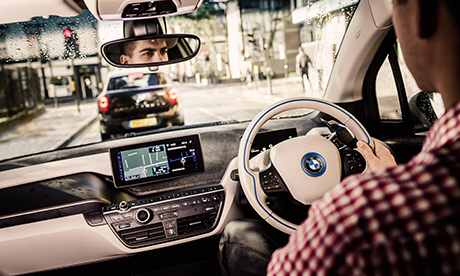Uber-kill? Taking the new BMW i3 for a spin with car share scheme DriveNow
As a car-sharing model, DriveNow has one big USP: their cars are not tied to car-club parking bays. So just find a car, take a one-way trip, and abandon it in any on street parking space within Islington, Haringey, Hackney or the southern half of Waltham Forest. As a pretty frequent Zipcar user, I tried DriveNow for a week to see how it compares.
DriveNow is cheaper to join – £29.99 for life compared to Zipcar’s £59.50 per year. But after joining, everything else is more expensive than Zipcar. An hour of DriveNow driving will cost £20 (for any car, any time), compared to £10.50 for the most expensive Zipcar (an Audi A3, weekend rate). You can get an hour with Zipcar for as little as £5.70, but for that you get a basic Vauxhall Corsa without Bluetooth and with maybe some bits missing.
For super short trips, DriveNow costs are more bearable. The normal per minute driving rate is 39p – one 15 minute early hours hop across Hackney was £5.84 – cheaper than a cab or many a local pint, and lots more fun. Parking time is 19p/min, though the car must be unoccupied for this rate – parked in a queue on the A12 doesn’t count.
There are occasional 25p/min Drive ‘n’ Save offers, and Zipcar also offers good discounts on overnight and multi-day bookings. For the prang-prone, both clubs offer insurance excess waivers. Zipcar will reduce the excess payment to zero for a £9.99 per month subscription and DriveNow will reduce the payment to £350 for £1.99 per booking.
On a Zipcar trip you check for damage, touch your membership card on the windscreen reader to instantly unlock the car, take the key out of the glovebox, start the car and drive – it feels like a rental, or like borrowing a car. On a DriveNow trip, the process is clunkier. The reader reacts slowly, you log in and start your booking (and sometimes the engine) with your PIN on the iDrive jogwheel.
Any damage is logged on the app and on a call made through the heavily branded iDrive interface, and any unexpected problems, like being unable to access any cars at all due to a global server outage, are logged by text message. On Zipcar, you call to report damage, so you can, Bluetooth permitting, report it after you set off. Apps for both services work well, offering quick access to reservations and car information.
The most common Zipcars are solid and responsive turbodiesel and petrol-engined VW Golfs, and less powerful but nonetheless nippy Corsas. DriveNow’s Internal Combustial Engine offerings are the sporty-handling BMW1 and the boxy All-Wheel Drive Mini Countryman. Both have automatic transmission, great at a clip but unsatisfyingly sluggish in sub-30mph start-stop London driving. The Countryman is truly the Boris bike of the car club arena – an unwieldy, swishy whale of a machine, little fun to pilot. And then, there is the electric car.
I could have spent my 700 words on the i3 alone – I can’t recommend this car highly enough. If DriveNow cost half as much and only offered the i3, I’d cancel my contract with Zipcar. Princess Co-pilot calls it “the space car” – it looks and feels futuristic, and is an absolute laugh-out-loud joy to drive. It goes from 0-30 in what-just-happened, and from 50-70 in oh-my-days-and-nights. Roller-coaster acceleration, instant torque, quick and direct steering, rear wheel drive, stiff suspension – everything about the car makes city driving ridiculously fun.
For longer bookings, school runs, airport pickups and the like, Zipcar is a more reliable and economical daily driver – there isn’t always going to be a DriveNow car on your road, and booking one ahead is expensive. That said, DriveNow is as cheap as a hackney cab or Uber for short trips, and the flat-out fun of driving the i3 is reason enough to sign up.
drive-now.com

